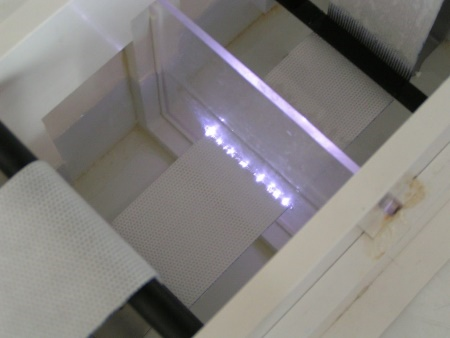Plasma sources for surface treatment of different materials
- Diffuse Coplanar Surface Barrier Discharge (DCSBD)
- Prototype ZUP200 for plasma treatment of nonwoven textile
- Diaphragm pulse discharge generating plasma in liquids
- Heated plasma reactor with DCSBD generating plasma in pure water vapor
- Experimental set-up for plasma polymerization
 |
 |
| Fig. 1. Low temperature DCSBD plasma |
Fig. 2. Device ZUP 200 for continuous plasma activation of narrow strips of thin materials – textiles. * The device was developed in the frame of |

Fig. 3. Diaphragm pulse discharge generating plasma in liquids
Research areas
- Breakdown mechanisms in water discharge and plasma generation by the electric pulsed diaphragm discharge in a liquid medium using electrical and optical measurements
- The changes on surface of the polymeric material treated by non-equilibrium plasma generated in the liquid medium using suitable surface diagnostic methods
- Surface modifications of different materials after non-equilibrium plasma generated in ambient air (N2, CO2, O2) treatment using suitable surface diagnostic methods (wettability, adhesion properties, ageing)
- Materials: nonwoven textile, polymers (PP,PET, PTFE, PMMA, PLA, etc.), glass, metals, oxides of metals, wood, silicon wafers and others
- Preparation of inorganic nanofibers (TiO2, Al2O3, CeO2, ZnO, ZrO2, etc.) from polymer template technique using low temperature plasma as an alternative to conventional thermal calcination

|
|
|
| Fig. 4. Significant increase of wettability of polymer textiles after short plasma treatment (in the order of seconds) |
Fig. 5. Cleaning and increase of surface energy of common glass and special glasses (ITO glass used in semiconductor industry |

Fig. 6. Improvement of adhesion of non-adhesive polymers (teflon) for further surface modification

Fig. 7. Plasma assisted calcination of inorganic nanofibers using DCSBD
Plasma diagnostics methods:
- Measurement of electrical parameters using current probe (Pearson Electronics Model 6600) and high voltage probe (type VD-100, 10000:1, High Voltage Products GmbH) together with digital oscilloscope (Agilent, DSOX3052A, 500 MHz, 4GSa/s) for accurate recording of the shape of discharge pulses.
- Study of fast processes associated with formation of the discharge by means of high-speed camera (type pgo.1200s, PCO A.G.)
- Optical diagnostics of plasmas by means of optical emission spectroscopy: UV-VIS spectrometer (Ocean Optics, USB2000), spectrometer Avantes,
- Investigation of effect of gases dissolved in form of bubbles in the reaction chamber on discharge ignition and plasma generation.
Diagnostics of changes on the surface of material:
- Evaluation of surface energy changes of plasma treated surfaces by means of the contact angle measurement (See System, Krüss DSA 30).
- The study of surface morphology (SEM, AFM)
- Elemental analysis (EDX, WDX)
- The characterization of chemical bonds present on surfaces of plasma treated materials FTIR
- Chemical composition of surface layer that corresponds to about 10 atomic layers (XPS)
Collaboration with:
- VÚTCH-CHEMITEX spol. s r.o., Žilina
- Pardam Nanotechnology, s.r.o., Czech Republic
- Singapore Institute of Manufacturing Technology
- Polymer Institute SAS, Bratislava
- Institute of Materials Research SASm Košice
- Faculty of Chemical and Food Technology STU, Bratislava
- Faculty of Science, Masaryk University, Brno
- University of Innsbruck
- Swiss Federal Laboratories for Materials Science and Technology, EMPA, Switzerland
Contact:
Doc. RNDr. Anna Zahoranová, PhD.
F2-40
Email: zahoranova(at)fmph.uniba.sk
Phone Nr: +421 2 602 95 529
Mgr. Dušan Kováčik, PhD.
F2-37
Email: kovacik(at)fmph.uniba.sk
Phone Nr: +421 2 602 95 616